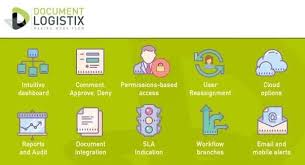In today’s fast-paced digital era, businesses deal with vast amounts of data and documents daily. From contracts and invoices to reports and project files, information keeps piling up, and managing it efficiently becomes crucial for productivity and growth. Without a proper system, companies often face problems like misplaced files, lack of collaboration, compliance issues, and wasted time searching for documents. This is where document management systems come into play.
By implementing the right tools, businesses can streamline processes, enhance collaboration, and secure sensitive information — all while reducing costs and manual workload. Let’s explore how document management can significantly improve workflow, along with practical tips and insights.
What is a Document Management System?
A document management system (DMS) is software designed to store, organize, and track electronic documents. Instead of relying on paper-based filing cabinets or scattered digital folders, a DMS provides a centralized, secure, and structured environment for handling all types of documents.
Modern solutions, such as Document management system software, allow businesses to:
Digitize and organize files into searchable databases
Automate version control to avoid confusion
Enable team collaboration in real time
Set permissions for document access and security
Comply with legal and industry regulations
In short, a DMS ensures that the right people can find the right documents at the right time.
Why Document Management Matters for Businesses
1. Saves Time and Increases Efficiency
Employees spend countless hours searching for misplaced files or requesting updates. A document management system eliminates this waste by offering instant search features, categorized storage, and easy retrieval.
2. Enhances Collaboration
In modern work environments, collaboration is key. Cloud-based systems let multiple users edit, share, and review documents simultaneously, ensuring that everyone works with the latest version.
3. Improves Security and Compliance
Sensitive files such as contracts, medical records, or financial reports require strict security. Document management tools provide role-based access control, encryption, and audit trails to maintain compliance with data regulations.
4. Reduces Costs
From printing and storage costs to reducing errors and wasted time, implementing a DMS directly impacts the bottom line. Less paper also means a more eco-friendly business approach.
5. Ensures Business Continuity
Paper files can be lost due to disasters, accidents, or misplacement. A DMS secures files in digital form, with backups and disaster recovery options.
Key Features to Look for in Document Management Systems
When choosing a DMS, businesses should evaluate several critical features:
User-Friendly Interface: Simple navigation ensures faster adoption among employees.
Advanced Search Functionality: Ability to locate documents using keywords, metadata, or full-text search.
Version Control: Tracks updates and ensures users always access the latest version.
Integration Capabilities: Connects with existing business software like CRM, ERP, and email.
Mobile Accessibility: Secure access from smartphones and tablets for remote work.
Scalability: The system should grow as your business expands.
Solutions like LogicalDOC provide these essential features, making them ideal for businesses aiming to modernize workflows.
How Document Management Improves Workflow Step by Step
Step 1: Centralizing Information
Instead of scattered folders across different drives, all files are stored in one place. This reduces confusion and duplication.
Step 2: Automating Processes
Automated workflows ensure documents move smoothly from creation to approval. For example, an invoice can be automatically routed to the finance team for review and then stored securely once approved.
Step 3: Supporting Remote Collaboration
With cloud-based access, teams working in different locations can collaborate in real time. This is particularly beneficial for hybrid or global businesses.
Step 4: Enhancing Security
Document permissions ensure sensitive information is only accessible to authorized personnel. This builds trust and reduces risks of breaches.
Step 5: Tracking and Monitoring
Audit trails and activity logs let businesses track who accessed or modified a file. This transparency is vital for accountability and compliance.
Best Practices for Implementing Document Management
Assess Business Needs
Identify pain points — is the biggest issue file retrieval, collaboration, or compliance? Tailor your DMS choice accordingly.
Train Employees
Successful adoption depends on employee readiness. Conduct training sessions and provide resources to ensure smooth usage.
Migrate Data Strategically
Organize existing files before migration to avoid carrying clutter into the new system.
Set Clear Policies
Establish guidelines for document naming, version control, and access rights.
Leverage Automation
Use automation for repetitive tasks like approvals, notifications, and archiving.
Regularly Update and Maintain
Keep your system up to date to ensure optimal performance and security.
Real-World Example: Improving Efficiency with a DMS
Consider a mid-sized law firm that previously relied on physical filing cabinets. Employees struggled to locate contracts quickly, resulting in missed deadlines and client dissatisfaction.
After switching to a digital document management system:
Retrieval time decreased from hours to seconds
Collaboration across offices became seamless
Compliance with legal standards improved
Overall client satisfaction increased significantly
This example highlights how even small to mid-sized businesses can transform productivity by adopting document management technology.
Future Trends in Document Management
The field of document management continues to evolve with technology. Some emerging trends include:
Artificial Intelligence Integration: AI will enhance search capabilities, automate classification, and improve compliance checks.
Blockchain Security: Immutable records stored using blockchain can enhance transparency and trust.
Deeper Integrations: Systems will integrate more seamlessly with business tools, offering unified dashboards.
Focus on User Experience: Modern solutions will become increasingly intuitive, ensuring ease of adoption.
Conclusion
Efficient workflow is no longer optional — it’s a competitive necessity. Businesses that still rely on manual or outdated systems risk falling behind. Implementing a reliable document management system software not only improves efficiency but also enhances security, collaboration, and compliance.
Whether your organization is small or enterprise-level, solutions like LogicalDOC can transform the way you handle documents, freeing up time and resources to focus on growth and innovation.
By embracing digital document management, businesses take a crucial step toward a more productive, secure, and future-ready workplace.
